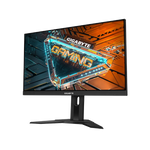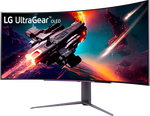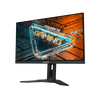A comparison of specs, key information, reviews, and best pricing from top retailers
Last updated -- hours ago | Report incorrect information
What we think

The PerfectRec monitor team Learn more
Updated April 22, 2024·
If you're on a budget and mainly involved in casual gaming or digital photo editing, the Gigabyte G24F-2 with its good refresh rate and strong color accuracy for sRGB content can offer a solid experience. However, for a premium, the MSI 45GS96QB will provide a more immersive experience due to its larger screen size and superior contrast, making it excellent for HDR gaming and media consumption, as well as for tasks demanding accurate P3 and AdobeRGB color reproduction. The MSI's wider screen and vivid colors are a big draw for creative professionals and serious gamers, but at a significantly higher cost. Give Feedback
this description is based on the product variant with some specs and product variant with some specs. At the time of writing, the variant with some specs cost some dollars and the variant with some specs cost some dollars.
Advantages of the Gigabyte G24F-2 (IPS)
- The Gigabyte G24F-2 (IPS) has no clear advantages over the MSI 45GS96QB (W-OLED).
Advantages of the MSI 45GS96QB (W-OLED)
- Best in class for casual gaming
- Very good refresh rate
- Best in class contrast
- Best in class response time
Key differences
Casual Gaming
5.7


9.5
1920 x 1080
RESOLUTION
3440 x 1440
170Hz
REFRESH RATE
240Hz
1100:1
NATIVE CONTRAST
Inf:1
300 nits
SDR PEAK BRIGHTNESS
275 nits
Unknown
HDR PEAK BRIGHTNESS
Unknown
95.0 %
DCI-P3 COLOR GAMUT
98.5 %
Matte
COATING
Matte
The MSI 45GS96QB (W-OLED) is best in class for casual gaming, while the Gigabyte G24F-2 (IPS) is poor.
Productivity
4.9


2.7
1920 x 1080
RESOLUTION
3440 x 1440
92 PPI
PIXELS PER INCH
Yes
ADJUSTABLE STAND
Yes
Matte
COATING
Matte
The Gigabyte G24F-2 (IPS) and MSI 45GS96QB (W-OLED) are both poor for productivity, though the Gigabyte G24F-2 (IPS) is somewhat better.
Cost
$140


$1,700
$0
$500
$1,000
$1,500
$2,000
$2,500
$3,000
The Gigabyte G24F-2 (IPS) has a price of $140 and the MSI 45GS96QB (W-OLED) costs $1,700.
HDR Gaming and Media Consumption
No


Yes
The Gigabyte G24F-2 (IPS) is not suitable for HDR gaming and media consumption while the MSI 45GS96QB (W-OLED) is suitable for HDR gaming and media consumption.
Key similarities
Competitive Gaming
5.8


5.9
170Hz
REFRESH RATE
240Hz
8.0 ms
TOTAL RESPONSE TIME
0.0 ms
48 - 180 Hz
VARIABLE REFRESH RATE
48 - 240 Hz
No
STROBING / BFI
No
300 nits
SDR PEAK BRIGHTNESS
275 nits
The MSI 45GS96QB (W-OLED) and Gigabyte G24F-2 (IPS) are both poor for competitive gaming.
Media Consumption
5.4


5.4
1920 x 1080
RESOLUTION
3440 x 1440
1100:1
NATIVE CONTRAST
Inf:1
300 nits
SDR PEAK BRIGHTNESS
275 nits
Unknown
HDR PEAK BRIGHTNESS
Unknown
Matte
COATING
Matte
The MSI 45GS96QB (W-OLED) and Gigabyte G24F-2 (IPS) are both poor for media consumption.
Digital Photo Editing
Yes


Yes
Both the Gigabyte G24F-2 (IPS) and MSI 45GS96QB (W-OLED) are suitable for digital photo editing.
HDR Video Editing and Color Grading
No


No
Both the Gigabyte G24F-2 (IPS) and MSI 45GS96QB (W-OLED) are not suitable for HDR video editing and color grading.
Print Photo Editing
Yes


Yes
Both the Gigabyte G24F-2 (IPS) and MSI 45GS96QB (W-OLED) are suitable for print photo editing.
Give feedback
We’re constantly working to improve.
How the Gigabyte G24F-2 (IPS) and the MSI 45GS96QB (W-OLED) compare to other monitors
Spec Comparison
| Gigabyte G24F-2 (IPS) | MSI 45GS96QB (W-OLED) |
GENERAL | |||
|---|---|---|---|
| Price | |||
$140 | $1,700 | ||
Screen Size | |||
Screen Size | 24" | 45" | |
Resolution | |||
Resolution | 1920 x 1080 | 3440 x 1440 | |
Screen Type | |||
Screen Type | LED | OLED | |
Screen Sub-type | |||
Screen Sub-type | IPS | W-OLED | |
Refresh Rate | |||
Refresh Rate | 170Hz | 240Hz | |
COLOR, CONTRAST & BRIGHTNESS | |||
|---|---|---|---|
Native Contrast | |||
Native Contrast | 1100:1 | Inf:1 | |
SDR Peak Brightness | |||
SDR Peak Brightness | 300 nits | 275 nits | |
HDR Peak Brightness | |||
HDR Peak Brightness | Unknown | Unknown | |
Suitable for HDR Gaming and Media Consumption | |||
Suitable for HDR Gaming and Media Consumption | No | Yes | |
sRGB Color Gamut | |||
sRGB Color Gamut | 125 % | Unknown | |
MOTION CHARACTERISTICS | |||
|---|---|---|---|
Total Response Time | |||
Total Response Time | 8 ms | 0.03 ms | |
Variable Refresh Rate | |||
Variable Refresh Rate | 48 - 180 Hz | 48 - 240 Hz | |
Strobing / BFI | |||
Strobing / BFI | No | No | |
Persistence Blur Score | |||
Persistence Blur Score | 7.1/10 | 8/10 | |
Ghosting Score | |||
Ghosting Score | 7.6/10 | 10/10 | |
TEXT & IMAGE CLARITY | |||
|---|---|---|---|
Pixels Per Inch | |||
Pixels Per Inch | 92 PPI | ||
Coating | |||
Coating | Matte | Matte | |
Text Clarity Score | |||
Text Clarity Score | 6.2/10 | 1.4/10 | |
Image Clarity Score | |||
Image Clarity Score | 6.2/10 | 2.5/10 | |
PORTS & CONNECTIVITY | |||
|---|---|---|---|
HDMI 1.4 Ports | |||
HDMI 1.4 Ports | 0 | 0 | |
HDMI 2.0 Ports | |||
HDMI 2.0 Ports | 2 | 0 | |
HDMI 2.1 Ports | |||
HDMI 2.1 Ports | 0 | 2 | |
Micro HDMI Ports | |||
Micro HDMI Ports | 0 | 0 | |
DisplayPort 1.2 Ports | |||
DisplayPort 1.2 Ports | 1 | 0 | |
Give feedback
We're constantly perfecting our model
More comparisons for you
Compare Gigabyte G24F-2 (IPS) vs. AOC 24G2SPU (IPS)
VS
Compare Gigabyte G24F-2 (IPS) vs. Lenovo G24-20 (IPS)
VS
Compare Gigabyte G24F-2 (IPS) vs. KTC H27T22 (IPS)
VS
Compare MSI 45GS96QB (W-OLED) vs. LG 45GR95QE (W-OLED)
VS
Compare MSI 45GS96QB (W-OLED) vs. Corsair 45WQHD240 (W-OLED)
VS
Compare MSI 45GS96QB (W-OLED) vs. LG 45GR95QE-B (W-OLED)
VS
FAQs
Why trust us
This information was produced and vetted by the PerfectRec monitors team. We are a product research and recommendation organization that meticulously reviews and evaluates the latest monitor information and makes it digestible for you.
By the numbers
210
Monitors evaluated
10,500
Monitors stats compiled
15
Proprietary Monitors ratings developed
117,500
Recommendations made
17,625
Consumer hours saved
About the monitor team
Joe Golden, Ph.D
CEO and Monitors Editor
Joe is an entrepreneur and lifelong electronics enthusiast with a Ph.D in Economics from the University of Michigan.
Jason Lew
Staff Expert & Software Engineer
Jason is a staff expert and software engineer that has been making laptop recommendations for 7 years and moderates one of the largest laptop subreddits.
Chandradeep Chowdhury
Staff Expert & Software Engineer
Chandradeep is a staff expert and software engineer and expert in televisions and monitors. He’s been making monitor recommendations for ten years.







